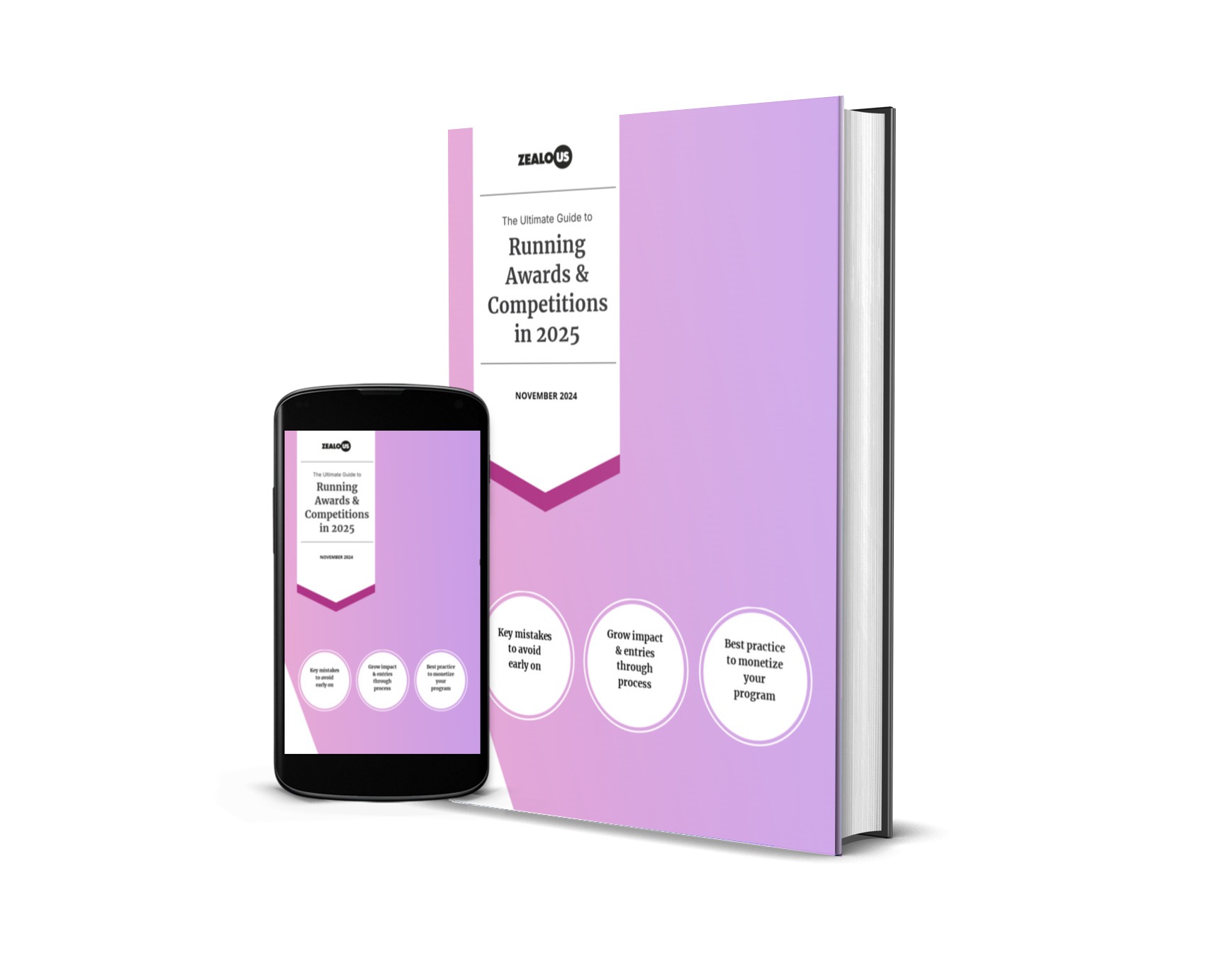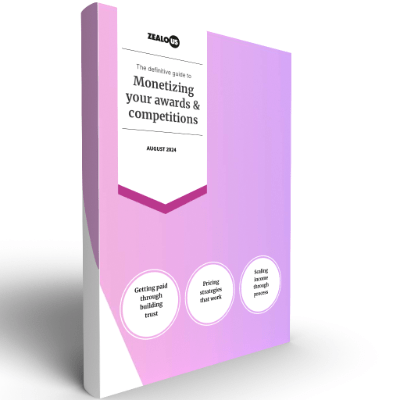This article covers:
- Choosing the right platforms for your specific audience
- Creating content that drives action, not just likes
- Designing for accessibility from day one
- Mastering campaign timing throughout your awards lifecycle
- Turning your network into your marketing team
- Budget-conscious tactics that deliver results
- Tracking which channels actually convert browsers into applicants
Your awards programme is exceptional. The judges are renowned, the prizes meaningful, your mission resonates. So why aren’t submissions flooding in?
Do potential entrants don’t know you exist yet? Or did they see your post once, scrolled past, and forgot.
These days breaking through requires more than posting and hoping. This article covers how to build a social media strategy that actually drives entries to your awards programme, even with limited budgets.
Choose platforms based on evidence, not assumptions
Posting everywhere exhausts your team and dilutes your message. Start with evidence.
Match platform to audience:
- Professional recognition programmes → LinkedIn (6.5% engagement rate, career-focused mindset)
- Visual/creative awards → Instagram (4-5% engagement for creative content, portfolio showcase)
- Youth-focused competitions → TikTok (2.5-7.5% engagement, but demands authentic video style)
- Industry-specific programmes → Where your past winners are already active
Research where similar programmes find success. Check where your judging panel discovers opportunities. Ask previous entrants where they spend time online (specialised listing sites could be a far better investment of time and resources!).
Platform Amplification
Modern platforms can amplify your reach through their existing networks. If your submission platform already has an engaged community, that distribution supplements your own social efforts at no cost.
Focus wins. Choose two or three platforms where your ideal entrants actually spend time, rather than maintaining weak presences across six.
Create content that converts, not just engages
A post with 500 likes that generates zero submissions wastes effort. Every social post should answer: “Why should I care enough to click through?”
Successful awards content falls into four categories:
1. Social proof that builds credibility
Feature past winners discussing specific impact (“This award led to gallery representation” not “winning changed my career”). User-generated content receives 8.7x higher engagement than branded posts.
2. Behind-the-scenes access that humanises your programme
Introduce judges with actual credentials and what excites them. Show your selection process (without revealing confidential details). People trust programmes they understand.
3. Educational content that positions your awards as valuable
If you recognise sustainable architecture, share emerging trends. Film awards can spotlight industry challenges. Establish authority, not just transactions.
4. Urgency triggers that prompt immediate action
Early bird deadlines, entry milestones (“100 submissions received!”), judge announcements, deadline reminders create reasons to engage now.
With 60-70% of social traffic from mobile devices, test every link. If applicants can’t explore your programme from phones, you’re losing entries.
Video Quality Over Quantity
Video has performed well this year, but execution matters enormously. A professional graphic featuring a past winner with a compelling quote will outperform a shaky, poorly-lit interview video every time. If you can’t produce quality video, strong static content delivers better results.
Design for accessibility
Where you post and how you present content directly impacts who applies. If your submissions lack diversity, audit whether your social presence unintentionally excludes people.
Accessibility is essential:
- Add captions to all videos → 85% of social video is watched without sound anyway, and captions make content accessible to Deaf and hard-of-hearing viewers
- Write descriptive alt-text for images → Screen readers should convey your message to blind and low-vision users (“Judge Maria Santos reviewing photography submissions” not “image-v2.09742875.jpg”)
- Avoid industry jargon without context → Insider language excludes outsiders who might be exactly who you’re seeking
- Test colour contrast → Ensure text is readable for people with colour blindness or vision impairments
- Keep videos under 60 seconds when possible → Accommodates people with attention differences and limited data plans
Accessible content broadens your applicant pool – platforms increasingly reward inclusive practices algorithmically. Making your content accessible to disabled people often makes it better for everyone.
Download launch checklist
Never miss a critical step: 300+ tasks across 8 phases, from securing judges to winner announcement.
Master campaign timing throughout your awards lifecycle
Your social strategy shouldn’t start when submissions open. Marketing should represent 30% of effort during planning, rising to 70% when live.
Map your timeline and identify content moments:
| Timeline | Content Focus | Post Frequency |
|---|---|---|
| 6-9 months before | Programme announcement, judge reveals | 2-3x weekly |
| 3-4 months before | Past winner spotlights, social proof | 2-3x weekly |
| 6-8 weeks before | Early bird closing, testimonials | 4-6x weekly |
| 2 weeks before | Daily countdown, FAQ answers, submission tips | Daily |
| Final 72 hours | Maximum visibility, multiple daily posts | 3-5x daily |
More than 50% of entries arrive in the final three days, but social awareness built earlier determines that final volume.
Want more articles like this?
Give this one a like
Turn your network into your marketing team
Your organisation’s reach is limited. Your judges, sponsors, past winners, and applicants combined have exponentially more reach.
Make sharing easy and worthwhile:
Judges: Create ready-to-share graphics announcing their involvement. Tag them in posts. Their participation is newsworthy to their networks. The best judges attract quality entries.
Sponsors: Offer structured social mentions in exchange for promoting your programme to their audiences. Create co-branded content serving both organisations.
Public voting: Transforms passive followers into active participants. When integrated seamlessly, each vote represents engagement and potential future entries. Secure mechanisms with GDPR-compliant capture can grow your mailing list while expanding awareness.
Past winners: Create annual traditions spotlighting alumni achievements. Most share enthusiastically. Professional results showcases become natural sharing content—make them visually compelling and mobile-optimised.
Current applicants: With permission, celebrate submissions as they arrive. “Incredible work coming in for [category]!” creates momentum and FOMO without revealing details.
Budget-conscious tactics
Effective social presence doesn’t require thousands in ad spend. It requires consistency and strategic thinking.
Tactics:
- Build relationships before launch → Engage with organisations serving your audience for months before asking them to share
- List on free directories → Industry opportunity listings provide persistent discoverability
- Create shareable assets → Infographics about categories/prizes get reused by applicants sharing with peers
- Repurpose intelligently → Tailor the same programme news differently for LinkedIn vs Instagram audiences
- Leverage platform features → Instagram Stories, LinkedIn articles, Facebook Events all boost reach organically
£50-100 could have a real impact. Check which posts have worked best for you, and then give them a little boost.
Where you post will directly impact who applies. If submissions lack diversity, your marketing likely reaches the same demographics repeatedly.
Track conversions, not vanity metrics
Engagement rates feel good (oh yes they do!) – but submissions is what actually matter.
Implement tracking to understand which channels drive entries:
Use UTM parameters in links showing whether Instagram, LinkedIn, or TikTok converted browsers into applicants. Most submission platforms provide referral source data.
Track systematically:
- Platform
- Content type
- Engagement (likes, comments, shares)
- Click-throughs to entry page
- Submissions within 24 hours
The Numbers
Good social conversion rates typically range 2-5% – meaning 95-98% of viewers won’t enter. That’s normal. Your goal is reaching enough qualified people that 2-5% fills your programme.
After your programme closes, analyse ruthlessly. That viral post with 5,000 likes generating two submissions underperformed the modest LinkedIn post driving 30 entries.
Measure against your own benchmarks. If you received 200 entries last year and 260 this year with strategic social efforts, that 30% increase is significant regardless of industry averages.
Insights like these straight to your inbox
Receive weekly tips from our founder to grow your program’s impact; regardless of what tools you use.
Handle common challenges before they derail your programme
Low engagement despite consistent posting?
Your content talks at your audience rather than to their needs. Audit recent posts: how many focused on applicant benefits versus organisational news? Shift toward educational and valuable content.
Great engagement but no submissions?
Your content captures attention but doesn’t drive action. Every post needs clear next steps. Link to your entry page, not just homepage.
Deadline approaching with insufficient entries?
Extend strategically (once only, or lose credibility). Announce across channels with new urgency messaging. Consider incentives for the extended window.
Negative comments you can’t answer publicly?
Respond promptly and professionally, directing detailed conversations to direct messages. Unanswered questions erode trust faster than criticism.
Team lacks social expertise?
Hire a freelancer for setup and initial content, then maintain internally. Authenticity matters more than polish in awards social media.
Platform-specific tactics for maximum impact
These change constantly as algorithms evolve, but at the time of writing these hold true.
Stories and Reels outperform static posts for reach. Use countdown stickers for deadlines. Share entry tips as carousel posts. Ensure your brand presence looks professional and cohesive.
Write thoughtful posts about why your awards exist and what winning means. LinkedIn’s algorithm favours personal accounts – encourage your team to share from their profiles.
TikTok
Only invest if you can commit to authentic, personality-driven video. Behind-the-scenes content showing real humans works. Staged corporate videos flop.
Events and Groups remain valuable for community building. Create an Event that people can share. Consider a closed Group for past entrants.
X (formerly Twitter)
Real-time updates work here. Thread your entry process. Engage in relevant conversations and naturally mention your programme when appropriate.
Threads
Growing rapidly with 275 million users, this Meta platform rewards conversational, authentic content. Less polished than Instagram, more personality than LinkedIn.
Create urgency without desperation
Humans procrastinate without pressure. More than 50% of entries arrive in the final three days because urgency triggers action.
Legitimate urgency tactics:
- Early bird pricing → 15-25% discount rewards immediate action and helps predict volumes
- Limited entry acceptance → “We accept only 500 entries” creates FOMO
- First submissions celebrated → (with permission) shows popularity and rewards early action
- Milestone announcements → “200 entries received!” builds momentum
- Strategic deadline extensions → Work once. Announce 7-10 days before original deadline that you’re extending two weeks due to demand
Never extend more than once, or future programmes suffer credibility damage.
Social media amplifies quality (it doesn’t replace it)
The best social strategy can’t save a programme applicants don’t trust or value. Before investing heavily in promotion, ensure your fundamentals are solid:
- Clear guidelines applicants understand without emailing questions
- Transparent judging that builds confidence in fair evaluation
- Meaningful recognition making entering worth applicants’ time and effort
- Professional presentation reflecting the calibre you’re seeking
Building trust with potential entrants matters more than any social tactic. Your awards’ reputation compounds across cycles. Applicants become advocates. Winners become ambassadors. Judges return annually.
Social media becomes the megaphone for something genuinely worth amplifying.
Your programme’s quality creates the foundation. Social strategy builds the visibility. Together, they fill your awards with the submissions you deserve.
You guessed it..
Zealous makes awards marketing seamless
But we’re not alone in the space—here are 8 others you may wish to consider (even if we would prefer you choose us!).
Want us to write more content like this? Give it a like
Share

Guy Armitage is the founder of Zealous and author of “Everyone is Creative“. He is on a mission to amplify the world’s creative potential.
Frequently Asked Questions
Which social media platform generates the most entries for awards programmes?
This depends on your audience. LinkedIn delivers 6.5% engagement for professional programmes. Instagram leads for creative awards at 4-5%. TikTok achieves 2.5-7.5% but requires authentic video content. Research where your past winners are active rather than chasing platform trends. Focus intensely on two or three platforms where ideal entrants spend time.
How far in advance should I start promoting my awards on social media?
Begin six to nine months before your deadline. Your marketing effort should represent 30% of work during planning, rising to 70% when submissions open. The biggest mistake is waiting until launch—you’ve then missed months of awareness-building.
Should I use paid social advertising or focus on organic reach?
Start with organic social and strategic partnerships, then add small paid campaigns (£50-100) to amplify what’s working. Test different messages, measure conversions not just engagement, and scale what delivers entries. Social advertising works when promoting something people value.
How do I measure whether social media is driving entries?
Track conversions, not vanity metrics. Use UTM parameters in links to identify which platforms drive traffic to your entry page. Most modern platforms provide referral source data. Social conversion rates typically range 2-5%. Measure success against your own benchmarks—if strategic efforts increased entries 25-30% year-over-year, that’s significant.
How can I increase social reach without a marketing budget?
Build relationships months beforehand with organisations serving your audience. Make sharing easy for judges, sponsors, and past winners with ready-to-share graphics. Public voting transforms passive followers into participants. List on free directories. Create shareable assets like entry guides that applicants reuse when telling peers. Time investment replaces budget.
What’s the biggest social media mistake awards programmes make?
Posting about themselves instead of addressing entrant needs. Shift toward educational content, social proof from past winners, and behind-the-scenes access. With 60-70% of social traffic from mobile, ensure your entry process works flawlessly on smartphones. Track conversions and do more of what drives submissions, not pretty engagement numbers.
How can I make my awards social media content more inclusive and accessible?
Start with captions on all videos—85% of social video is watched without sound, and captions make content accessible to Deaf viewers. Add descriptive alt-text to images so screen readers convey your message (“Past winner showcasing sculpture” not “IMG_1234”). Avoid industry jargon without context that excludes outsiders. Test colour contrast ensuring text is readable. Keep videos under 60 seconds when possible. Accessible content often performs better algorithmically because platforms reward inclusive practices, and you’ll reach qualified applicants who were previously excluded.
How often should I post about my awards on social media?
During awareness-building (six to nine months before), post 2-3x weekly. Intensify to 4-6x weekly approaching deadlines. Final two weeks shift to daily content. Final 72 hours justify multiple daily posts. Quality trumps volume—one compelling weekly post driving entries beats daily generic content people scroll past.









